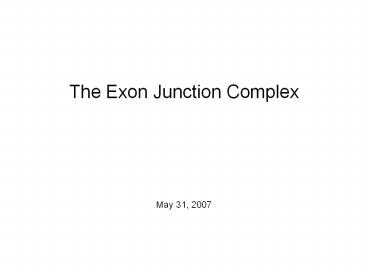The Exon Junction Complex - PowerPoint PPT Presentation
Title:
The Exon Junction Complex
Description:
A 5' end export B non 5' end export C translationally silent ... human Mago and Y14) required for proper localization during oogenesis (Palacios. Nature. ... – PowerPoint PPT presentation
Number of Views:584
Avg rating:3.0/5.0
Title: The Exon Junction Complex
1
The Exon Junction Complex
May 31, 2007
2
Introduction
- mRNA Processing
- The Exon Junction Complex Components and Roles
- The Core Y14, Mago, Barentsz and eIF4AIII
- Previous Biochemical Studies
3
Fates of mRNA
A 5 end export
B non 5 end export C
translationally silent D - transport
Moore. Science. 2005
4
What is the Exon Junction Complex (EJC)?
- Macromolecular complex deposited on mRNA due to
pre-mRNA splicing - Deposited 20 nucleotides upstream of exon-exon
junctions - Position-dependent
- Sequence-independent
- ATP-dependent complex
- Four core proteins
- eIF4AIII
- Y14
- Magoh (Mago)
- Barentsz (MLN51)
- Peripheral proteins
Tange et al. RNA. 2005
Stroupe et al. JMB. 2006
5
EJC as a Mediator of mRNA Functions
EJC
- Localization
- Translation
- Decay (Quality Control)
EJC
Le Hir et al. TIBS. 2003
6
EJC and mRNA Localization
- Nuclear Export
- Early studies - EJC stimulates mRNA export in
Xenopus oocytes by acting as a binding platform.
(Le Hir. EMBO J. 2001) - Knockdowns in Drosophila (Gatfield. J Cell Bio.
2002) and C. elegans (Longman. RNA. 2003) suggest
mRNA export may be enhanced by EJCs. - Drosophila oskar mRNA Localization
- EJC components (homologues of human Mago and Y14)
required for proper localization during oogenesis
(Palacios. Nature. 2004, Hatchet. Nature 2004)
Hatchet et al. Nature. 2004
7
EJC and mRNA Translation
- Splicing influences mRNA translational yield in
Xenopus oocytes (Braddock. Nucleic Acids Res.
1994) - Also found to be true in mammalian cells
- Spliced mRNA leads to more protein than unspliced
(Lu. RNA. 2003, Nott. RNA. 2003) - Expression profiles of mRNAs with exons too short
or just long enough to accept EJC (Wiegand. PNAS.
2003, Nott. Genes Dev. 2004) - Y14 and Mago can enhance translational yield when
tethered to reporter mRNA (Nott. Genes Dev. 2004) - Polysome analysis (Nott. Genes Dev. 2004)
8
- EJC and Nonsense-Mediated Decay
(NMD) - a mechanism of surveillance/ QC whereby
aberrant mRNAs with Premature Translation-Stop
Codons (PTCs) are degraded
Rehwinkel et al. TIBS. 2006
9
EJC Core Components - Y14Mago
Mago
- Associate to form a tight heterodimer
- Associate with the spliceosome
- Y14 has RNA Recognition Motif (RRM)
- Does not bind RNA
- RRM is buried at dimer interface with Mago
Y14
Lau et al. Curr Bio. 2003
10
EJC Core Components - Y14Mago
Mago
- Associate to form a tight heterodimer
- Associate with the spliceosome
- Y14 has RNA Recognition Motif (RRM)
- Does not bind RNA
- RRM is buried at dimer interface with Mago
Y14
Lau et al. Curr Bio. 2003
- Main role of Y14Mago - inhibition of ATP
hydrolysis to lock eIF4AIII into a conformation
that cannot release RNA
11
EJC Core Components - Barentsz and eIF4AIII
- Barentsz and eIF4AIII directly interact in EJC
- Both contribute to RNA binding
- Barentsz contains SeLoR motif at N-terminus
- Speckle Localizer and RNA binding
- Non-specific RNA binding
- Directs to sub-nuclear speckle domains enriched
in splicing factors - eIF4AIII is a DEAD-box Helicase
12
DEAD-box Helicases
(asp-glu-ala-asp)
- Regulate essentially all processes involving RNA
- ATP-dependent
- Several conserved motifs
- Grouped into superfamilies based on these
- ATPase and helicase activity, RNA binding
Cordin et al. Gene. 2006
13
eIF4A A DEAD-box Helicase
Motif Ib (TPGRVFD)
Motif II Walker B (DEAD)
Motif VI (HRIGRGGR)
GG
Motif Ia (PTRELA)
Motif V (RGID)
Motif I Walker A (SGTGKT)
Motif III (SAT)
Conserved R Motif
Motif IV (VIFCNT)
Caruthers et al. PNAS. 2000
14
Ded1 A Mischievous DEAD-box Helicase
EJC
Ded1
Cordin et al. Gene. 2006
15
RNA Binding of eIF4AIII
- Stimulates ATPase activity
- Cooperativity between RNA and ATP binding
- Reduced binding in the presence of ADP
- Not known how distinguishes RNA from DNA
- Helicase activity of eIF4AIII not used in EJC
- Nucleotides protected (6 v. 8)
16
Previous Biochemical Studies
- Co-precipitations show interactions between 4
core components (Ballut et al. Nature Struct Mol
Bio. 2005) - Mutational analysis of eIF4AIII identifies
regions required for EJC formation (Shibuya et
al. RNA. 2006)
17
Co-precipitation of Core Components
Ballut et al. Nature Struct Mol Bio. 2005
18
eIF4aIII Mago Interactions
Shibuya et al. RNA. 2006
19
EJC - Leading to the paper
- Core Complex Y14/Mago/Barentsz/eIF4AIII
- Formed during mRNA splicing
- Binds RNA in an ATP-dependent manner
- Involved in mRNA localization, translation, and
decay - Chris Crystal Structure of the Core Complex































